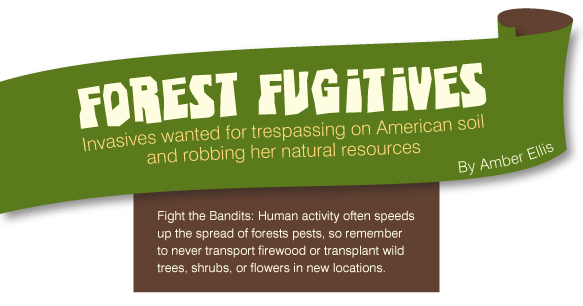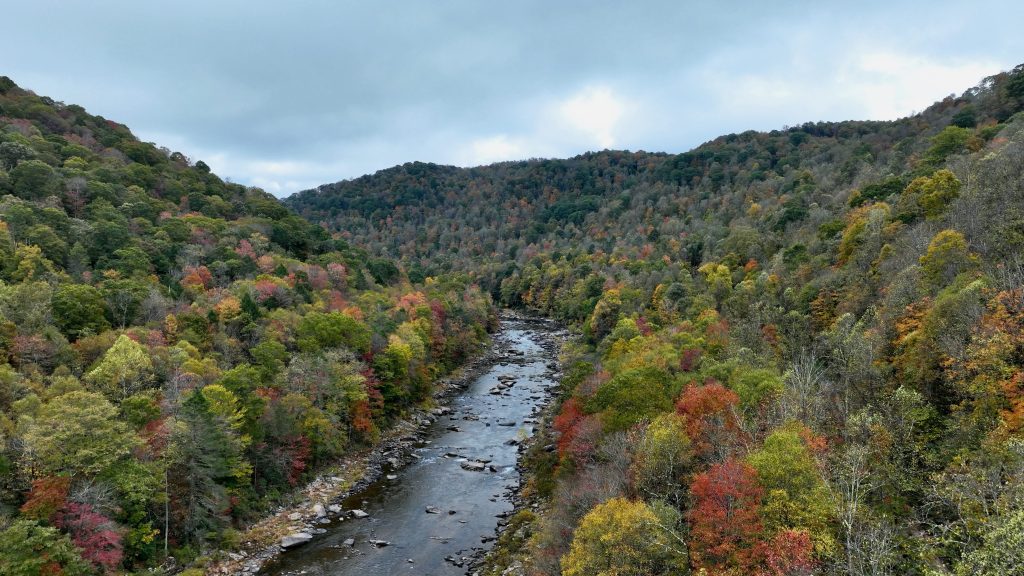
ORIGIN: Eastern Russia, northern China, Japan and Korea
VICTIMS: Any ash tree species
CRIME: Bores under bark, destroying the tree’s water and nutrient transportation systems
PRESENCE IN APPALACHIA: North Carolina, Kentucky, Virginia, West Virginia and Tennessee
CONTROL METHODS: Insecticide is the only effective means of control thus far
DON’T BE FOOLED: Adult emerald ash borers are a deceptively beautiful deep, metallic green
Photo courtesy of U.S. Dept. of Agriculture Forest Service
ORIGIN: Temperate Asia and Europe
VICTIMS: Prefers deciduous hardwoods, especially oaks, but can attack hundreds of tree species
CRIME: Defoliation due to feeding
PRESENCE IN APPALACHIA: western North Carolina, Virginia and West Virginia
CONTROL METHODS: Insecticide, Gypsy Moth traps and “tree banding” to trap and kill caterpillars
FUN FACT: The gypsy moth was brought to America in 1869 in the hopes of starting a domestic silkworm industry. It escaped, and things went horribly wrong.
Photo courtesy of Flickr user Gailhampshire
CAUSE: Fungus,
Discula destructiva
ORIGIN: Unknown
VICTIMS: Dogwood, all eastern flowering varieties
CRIME: Infects young twigs, shoots and leaves. Cankers then grow out of infected areas and cut off nutrient and water supply.
PRESENCE IN APPALACHIA: Throughout central and southern Appalachia
CONTROL METHODS: No control methods are currently effective for forest areas, but fungicide and proper maintenance can help protect ornamentals.
SURVIVAL STORY: A wild anthracnose-resistant species was discovered in Maryland, dubbed the “Appalachian Spring Dogwood” and began being commercially cloned and sold in 2000.
Photo courtesy of U.S. Dept. of Agriculture Forest Service
CAUSE: Beech Scale Insect,
Cryptococcus fagisuga;
Noninvasive fungi,
Neonectria faginata, Neonectria ditissima
ORIGIN: Unknown, but insect first documented
in Europe
VICTIMS: American beech, Fagus grandifolia
crime: The beech scale insect burrows under the bark to feed on the sap of the tree. The fungi can then enter the tree easily through the wounds made by the insects, causing cankers and eventually tree death.
PRESENCE IN APPALACHIA: eastern West Virginia, East Tennessee and western North Carolina
CONTROL METHODS: Salvage cutting and insecticides
SLOW AND STEADY: The scale insect was accidentally brought to Nova Scotia, Canada, in 1890, and by 1981 had reached roughly 70,000 acres in West Virginia.
Photo courtesy of U.S. Dept. of Agriculture Forest Service
CAUSE: Water mold,
Phytophthora cinnamomi
ORIGIN: Unknown, but invasively present in more than 70 countries
VICTIMS: Shortleaf, slash, loblolly, pitch, Virginia, and longleaf pines
CRIME: Infects root hairs of trees in perpetually wet and/or poorly drained soil. The disease causes needles to turn yellowish brown and the production of excess cones
PRESENCE IN APPALACHIA: east Tennessee and southeastern Kentucky
CONTROL METHODS: Remove trees with the disease, and maintain well-drained soil
REPEAT OFFENDER: The same fungus that is responsible for littleleaf disease is responsible for root rot of avocado trees, a major problem in the avocado farming business.
Photo courtesy of U.S. Dept. of Agriculture Forest Service
CAUSE: Fungus,
Sirococcus clavigignenti
ORIGIN: Unknown
VICTIMS: Mainly attacks the butternut tree (white walnut) but has been found in other walnut tree species; isolated incidents of hickory tree infection
CRIME: Fungus usually spreads through water and animals, and causes cankers originating from leaf scars and buds
PRESENCE IN APPALACHIA: western North Carolina and Virginia, Tennessee, and eastern Kentucky and West Virginia
CONTROL METHODS: Some resistant genetics have been found, but research is still needed
SURVIVAL STORY: As of 2013 the butternut populations in North Carolina and Virginia have decreased by nearly 80% due to butternut canker disease.
Photo courtesy of U.S. Dept. of Agriculture Forest Service
Related Articles
Latest News

Leave a comment
Your email address will not be published. Required fields are marked *











Leave a Comment